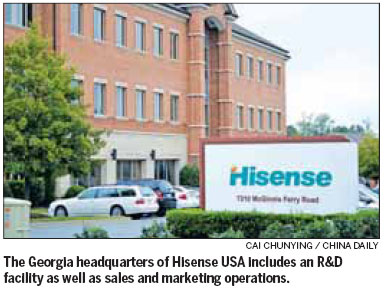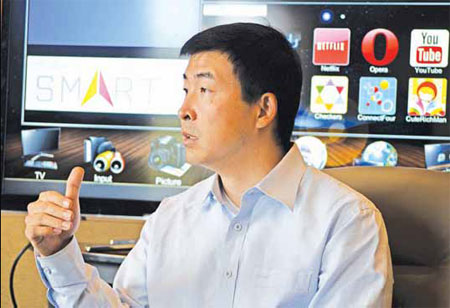For Hisense, all eyes are on US profile
Updated: 2012-11-23 12:46
By Tan Yingzi in Suwanee, Georgia (China Daily)
|
||||||||
|
Lawrence Li, CEO of Hisense USA Corp, is focused on increasing the company's brand recognition in the US. The subsidiary is moving toward a 50-50 split between producing its own electronics and appliances and serving as a contract manufacturer for other firms. Cai Chunying / China Daily |

In 2009, China's Hisense Electric Co was trying to get its flat-panel televisions sold at HH Gregg, a chain of home-appliance stores mainly in the US South.
But with no brand recognition among American consumers, the company only persuade the retailer to sell three relatively small models.
Both the Chinese manufacturer and HH Gregg were uncertain about the sales prospects for their new, albeit tentative, alliance. To their surprise, the Hisense televisions sold quickly. Within a month, the retailer had sold over 10,000 of each of the three models, according to Hisense USA Corp CEO Lawrence Li.
Building on that strong launch, HH Gregg introduced more smaller Hisense TVs over the next few months, then several models of midrange to high-end "smart" Internet-enabled and LED televisions.
"Nowadays, many US national retailers and consumers have realized that Hisense is not another Chinese brand," Li said in an interview at the offices of the company's US subsidiary in Suwanee, Georgia, less than an hour's drive from Atlanta.
The three-story, red-brick building houses a 40-member research-and-development team, as well as sales and marketing departments.
Li acknowledged the stereotype of Chinese-made products as cheap and poorly made. But Hisense, he said, exemplifies a new vision of Made in China that combines high quality with advanced technology and even cutting-edge innovation.
Established in 2001, Hisense USA is a subsidiary of Hisense Electric, a home-appliance and electronics maker based in Qingdao, in eastern China's Shandong province. Last year, the parent company had $11.8 billion in worldwide sales.
Known as one of the world's biggest makers of flat-panel TVs, the company also makes appliances such as refrigerators and heaters, and is emerging as a leader in the manufacture of mobile handsets.
This year, Hisense was honored with a Value Innovation Award for its tablet-like ITV2 product at the Consumer Electronics Show in Las Vegas.
With about 60,000 employees worldwide, Hisense has R&D centers in Qingdao, Shenzhen, Shunde and Beijing, as well as in Suwanee and Europe. Its non-Chinese manufacturing operations are in South Africa, Algeria and Egypt, with sales offices in the United States, Europe, Australia, the Middle East and Southeast Asia. It exports to over 130 countries and regions.
But the company's foray into North American 11 years ago was met with suspicion.
"People here used to look at us through 'colored glasses'," Li said, due to their experience with Chinese products.
"Though they knew about Hisense as a leading Chinese manufacturer, they never saw a Hisense TV in their market."
To build its reputation, the company started as an original-equipment manufacturer, or OEM, for recognized brands - a strategy emphasized from 2001 to 2008.
Since 2009, Hisense has been selling its own branded wares directly to North American retailers such as HH Gregg's parent, Gregg Appliances Inc; Best Buy Co; Wal-Mart Stores Inc; Costco Wholesale Corp, for online sales; and Canadian Tire Corp.
It is currently working with the Massachusetts Institute of Technology to develop new products. Hisense is sponsoring research at MIT's Media Lab, sending its own R&D specialists to work with faculty and students on developing smart TVs, including those with 3-D capabilities and voice recognition, and other electronics.
The pursuit of innovation has brought international recognition. In early 2010, Hisense Group Chairman Zhou Houjian became the first Chinese executive to give a keynote speech at the Consumer Electronics Show, among the industry's most important events.
Hisense now is raising its brand awareness in North America.
JoAnne Foist, marketing director for Hisense USA, said the company has positioned itself as "the most preferred Tier 2 brand as a step toward becoming a Tier 1 brand".
Among flat-panel televisions, Tier 2 brands include Panasonic, Sharp and Toshiba while the higher-echelon Tier 1 comprises Samsung, Sony and LG. The company has studied the successes of those rivals, all of which are Asian and all of which were once unknown to American consumers.
Foist, a veteran American marketing professional, joined the Chinese company in 2011. She previously worked as a consultant to a US marketing firm.
She described Hisense strategy as promoting "same features, better price" or "same price, better features".
In her mind, the national origin of a brand isn't that important to US consumers.
"If you ask people where Samsung comes from, most don't know it's from South Korea. So it is not necessary for us to say this is from China and we are a Chinese brand. We talk about features and benefits."
Foist's plans for Hisense include placing ads at sporting events, product tie-ins with popular national TV programs and educating consumers about smart-TV technology.
"Hisense has a clear goal for its global expansion and we have long-term strategy in North America," Li said. "Once we enter a market, we won't ever retreat."
With revenue from its success in China's booming domestic market, Hisense has the resources to aggressively expand abroad.
"Since 2008, the group has invested over $100 million in the North America market," Li said.
In 2011, the US subsidiary had $370 million in sales, 35 percent of which was from its own brand. It's expected to reach $ 580 million this year, with revenue split 50-50 between own-brand and OEM revenues, according to Li.
Over the next five years, Hisense USA is likely to pursue mergers and acquisitions in North America, especially in the technology of software development and system integration, the executive said. A production plant in Mexico is already under consideration, he added.
tanyingzi@chinadailyusa.com

 Relief reaches isolated village
Relief reaches isolated village
 Rainfall poses new threats to quake-hit region
Rainfall poses new threats to quake-hit region
 Funerals begin for Boston bombing victims
Funerals begin for Boston bombing victims
 Quake takeaway from China's Air Force
Quake takeaway from China's Air Force
 Obama celebrates young inventors at science fair
Obama celebrates young inventors at science fair
 Earth Day marked around the world
Earth Day marked around the world
 Volunteer team helping students find sense of normalcy
Volunteer team helping students find sense of normalcy
 Ethnic groups quick to join rescue efforts
Ethnic groups quick to join rescue efforts
Most Viewed
Editor's Picks

|

|

|

|

|

|
Today's Top News
Health new priority for quake zone
Xi meets US top military officer
Japan's boats driven out of Diaoyu
China mulls online shopping legislation
Bird flu death toll rises to 22
Putin appoints new ambassador to China
Japanese ships blocked from Diaoyu Islands
Inspired by Guan, more Chinese pick up golf
US Weekly

|

|







